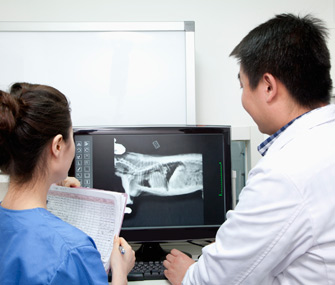Why Veterinary Radiologists Are So Important
Published on May 11, 2015

If I had to pick only one career for my 17-year-old son, it would be in radiology. I mean, what’s not to love? You get to be curious, skeptical, analytical and creative all at once. And if you’re good enough at reading images, you could do it while basking in the sun atop the black sands of a Polynesian beach if you wanted to, thanks to digital imaging and the Internet. Now that’s a work-life balance I can get behind!
Practically speaking, however, the field of veterinary radiology is a lot less sexy than a Hawaiian beach would suggest. In fact, its practice is largely restricted to those who don’t mind sitting on their butts for a living. (Video gamers, please apply.) Lest that sounds like it’s easy, consider that after earning a veterinary degree, it generally takes a three-year residency and passing scores on tough exams to become a board-certified veterinary radiologist.
Then there’s this depressing reality: Most people don’t even know they exist. Though I rely on radiology specialists to help me interpret up to 90 percent of the X-ray images I take, pet owners would never suspect that another veterinarian was weighing in unless I told them so. In fact, many of my clients are shocked that any such animal actually exists. (“A veterinarian who does nothing but look at X-rays all day? Really?”)
The Value of an Expert Opinion
Still, I would no more forgo veterinary radiologists when interpreting an X-ray than I would a pathologist when analyzing a tumor’s tissues microscopically. Why would I? They’re the experts. They do it all day long!
Sure, I’ve gotten to be quite good at interpreting my own X-rays, but even my current skills were sharpened with the help of radiology specialists. After all, I came up in a time when having my X-rays interpreted by a radiologist meant snail-mailing those giant rectangles of photographic film to the nearest vet school and awaiting a faxed reply (or begging a local specialist to “take a quick look”). It wasn’t very expedient and didn’t help a large percentage of my patients (who needed stat assessments), but it did the trick back in the day. Thankfully, things are different now.
Timely Insights for Better Care
Fast-forward 20 years, and it’s now clear that the technology of digital radiology has revolutionized the practice of veterinary medicine. Here are some examples:
- The fact that I can take a picture of my patient’s lungs at 9 a.m. and get a definitive answer by 9:20 a.m. means I can either start treating her pneumonia ASAP or send her straightaway to a cardiologist.
- It means I can have someone else help me find a foreign body in the intestine or a mass on the spleen.
- It also means I don’t have to schlep across town to ask a surgeon whether that change in the bone looks like it needs to be biopsied or not.
Want to know just how useful veterinary radiologists are? This week alone has seen three of my own pets’ radiographic images sent digitally to the group of radiologists I like to use. Consider:
Tika: This is my 10-year-old Belgian Malinois, whose chronic allergic bronchitis has been worrying me of late. In this case, the radiologist was able to tell me definitively that the pattern in her lungs has not changed significantly, that it does not look like cancer (my worst fear) and that I should perform another bronchoalveolar lavage (an airway cell-sampling test) to determine whether anything further has changed.
Violet: My 2-year-old Belgian Malinois did what any 2-year-old Belgian Malinois dog would do. She ripped her claw while running through my wooded yard. After a week, it hadn’t healed properly, so I took an X-ray. Finding a tiny suspicious area made me wonder whether I was missing the beginnings of a nail bed tumor (rare at her age, but it could happen). The radiologist confirmed that it was only a small bit of foreign material, which I subsequently extracted under anesthesia.
Slumdog: My 6-year-old Pug mix jumped off the sofa one rainy day this week and twisted his limb. Since he has an implant there from a previous orthopedic surgery, I was concerned the screws might have loosened (which would require surgical intervention). Luckily, the radiologists were there to assure me that everything was still in place and that all the swelling appeared to be confined to the soft tissues. Cage rest and anti-inflammatory meds fixed him right up.
After a week like that, is it any wonder I want my son to grow up to be a veterinary radiologist? I think not. In fact, after a week like that, it’s a wonder I don’t apply for a residency program myself!
More from Vetstreet:





